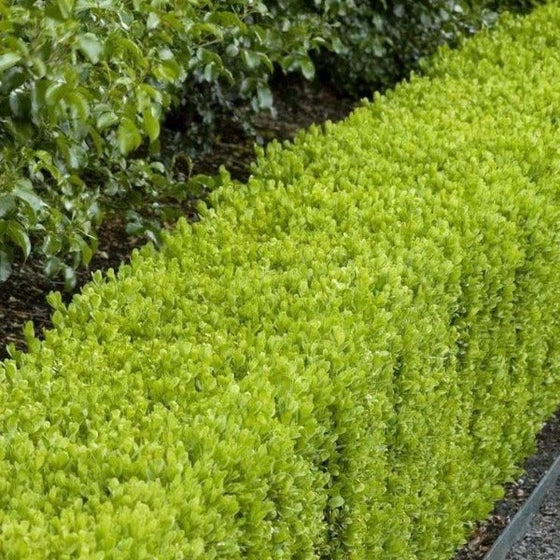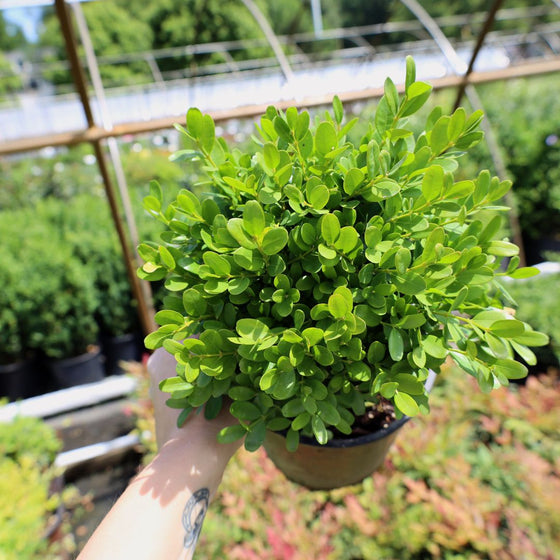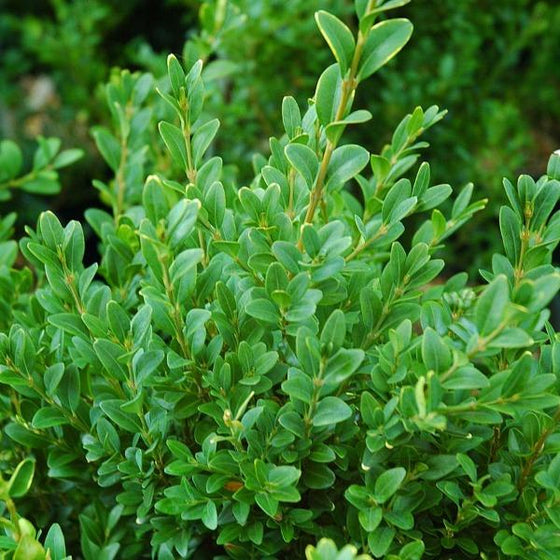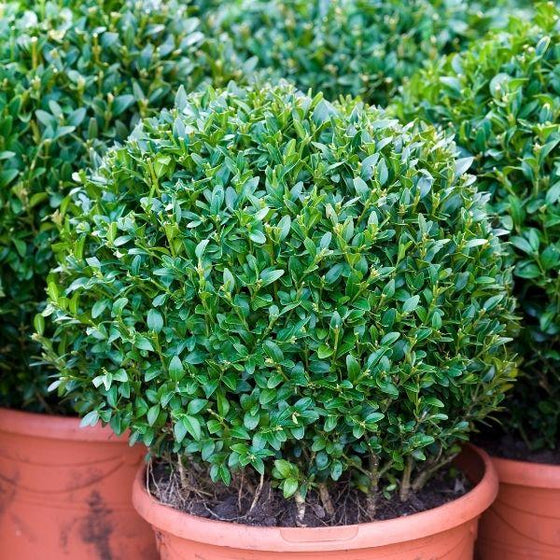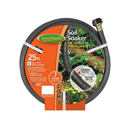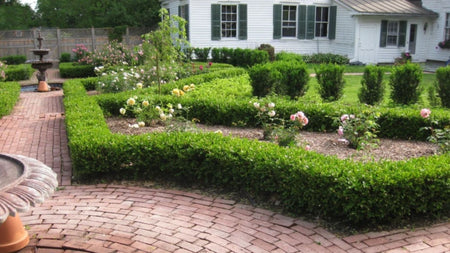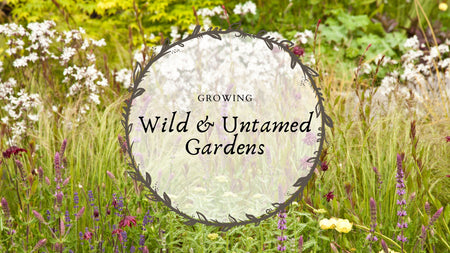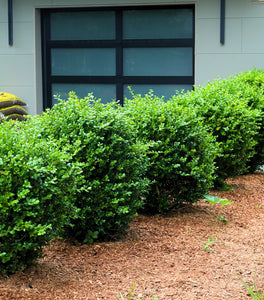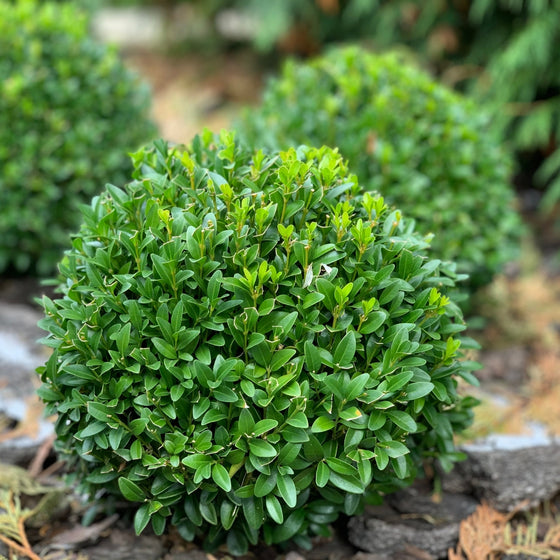
Images Depict Mature Plants
Dwarf English Boxwood – Buxus ‘Suffruticosa’
Timeless elegance for formal gardens.
Dwarf English Boxwood (Buxus sempervirens ‘Suffruticosa’) is the classic evergreen for formal low hedges, knot gardens, and parterre borders. Its dense, fine-textured foliage naturally forms a compact, rounded habit that adds year-round structure and rich green color to any landscape. Whether framing a walkway, edging a perennial bed, or creating intricate geometric patterns, this boxwood offers unmatched refinement and curb appeal.
Slow-growing and low-maintenance.
This slow-growing dwarf boxwood reaches 2–3 feet tall and wide, making it perfect for low hedges or garden edging without the need for constant pruning. Hardy in USDA Zones 5–8, it thrives in full sun to partial shade and adapts well to a variety of soil types as long as drainage is good. Its steady growth habit means less clipping while maintaining a tidy, formal look.
Versatile design possibilities.
Use Dwarf English Boxwood as a foundation planting, border, or accent in formal landscapes. Its compact size makes it ideal for small-space gardens, historic landscapes, or topiary projects. Pair it with flowering shrubs or perennials for striking seasonal contrast, or plant a series to create an elegant evergreen walkway border.
Year-round beauty with little effort.
Unlike deciduous plants that fade in winter, this deer-resistant evergreen keeps its glossy green foliage all year long. Its tolerance of both sun and shade and its ability to thrive with minimal care make it a low-maintenance choice for gardeners and landscapers who want lasting color and structure.
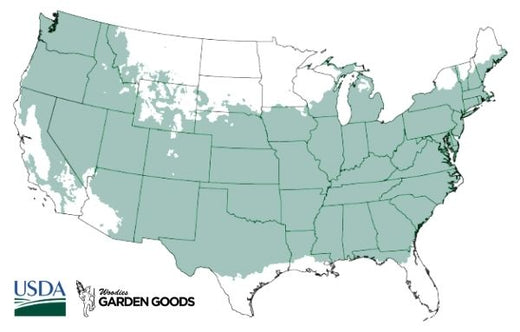
| Hardiness Zone: | 5-8 |
|---|---|
| Mature Height: | 2 to 3 Feet |
| Mature Width: | 2 to 3 Feet |
| Classification: | Dwarf evergreen shrub |
| Sunlight: | Full sun to part shade |
| Habit: | Upright |
| Flower Color: | Inconspicuous |
| Foliage: | New growth emerges bright green changes to dark green as it matures |
| Soil Condition: | Any well drained soil |
How to Care for Dwarf English Boxwood
Be sure to read our planting instructions to ensure a healthy and happy Dwarf English Boxwood plant for years to come!
How do I plant Dwarf English Boxwood for a formal low hedge?
Choose a location with full sun to partial shade and well-drained soil. Dig holes twice as wide as the root ball but no deeper, spacing plants 18–24 inches apart for a dense hedge or wider for individual accents. Set the shrub so the top of the root ball is level with the surrounding soil, backfill halfway, water thoroughly to settle, then finish filling and water again. Apply a 2–3 inch layer of mulch, keeping it a few inches from the trunk to prevent rot. Plant in early spring or early fall, when cooler weather helps roots establish quickly and supports long-term health.
How often should I water Dwarf English Boxwood after planting?
During the first growing season, water deeply once or twice a week, ensuring the soil stays consistently moist but not soggy. Consistent moisture during establishment encourages strong root growth and helps maintain the shrub’s dense, glossy foliage. After the first year, Dwarf English Boxwood is moderately drought-tolerant, requiring supplemental water only during extended dry periods. Maintain a 2–3 inch mulch layer to conserve soil moisture and protect roots from temperature extremes.
When and how should I fertilize Dwarf English Boxwood?
Fertilize in early spring with a balanced, slow-release shrub fertilizer to promote healthy foliage and steady growth. Spread the fertilizer evenly around the drip line—about a foot out from the trunk—and water well to help nutrients penetrate the soil. A single annual feeding is usually sufficient to keep the lush evergreen foliage vibrant and the plant growing steadily. Avoid late-summer fertilization so new growth can harden before winter.

Do Dwarf English Boxwoods need regular pruning?
This cultivar naturally maintains a rounded, compact shape, so only light pruning is required. In late spring or early summer, after the first flush of new growth, lightly shear or hand-prune to refine the shape or maintain formal hedge lines. Avoid heavy cuts into old wood since boxwoods do not regenerate from bare stems. With occasional light trimming, your formal evergreen border or knot garden will stay neat and elegant year-round.

